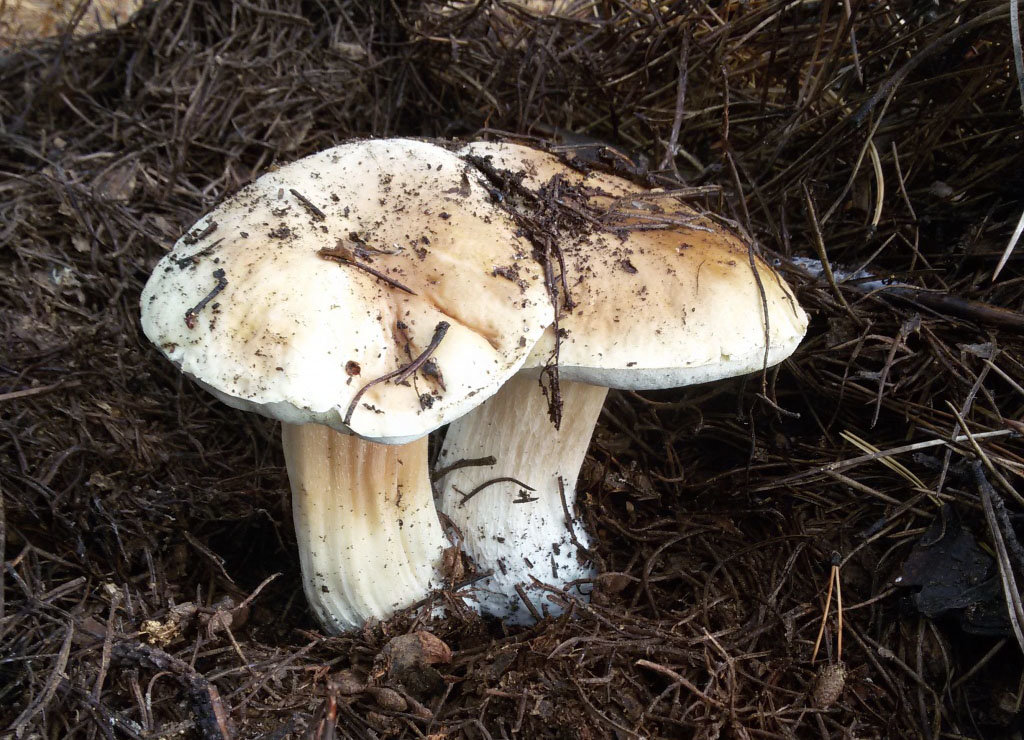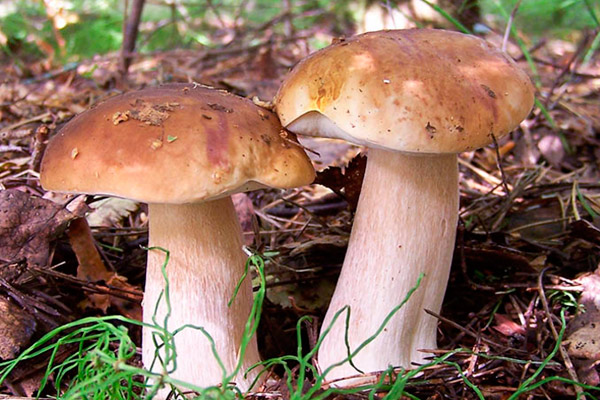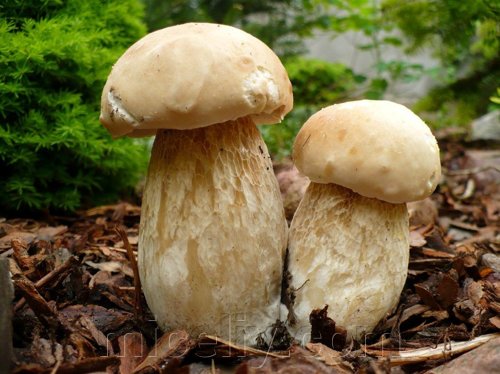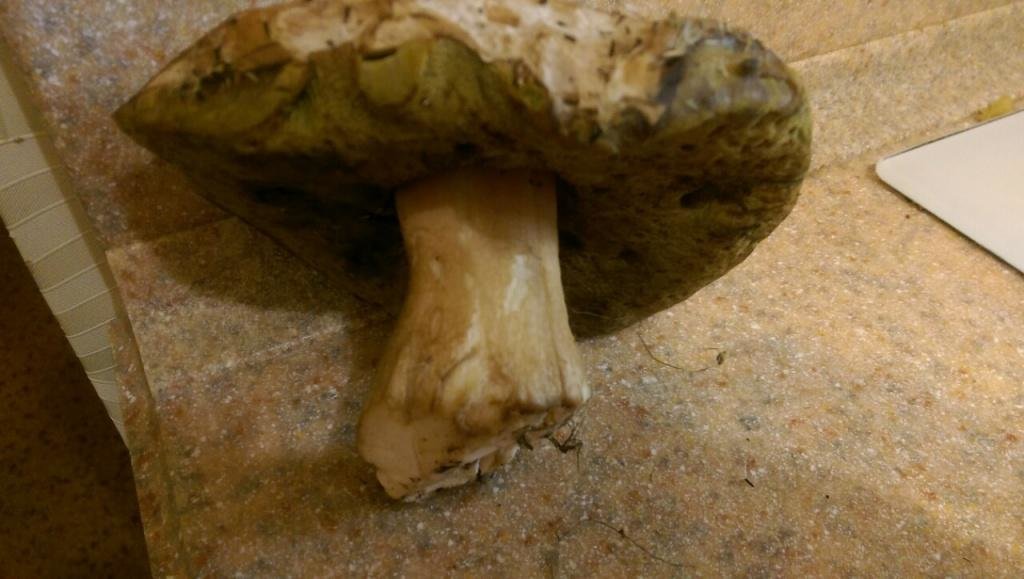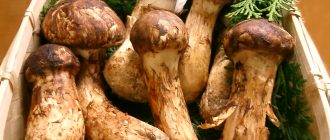Who can be confused with?
Usually boletus is confused with a gall fungus (false boletus). Signs by which they can be recognized:
- By cut color. In the gall fungus, the flesh becomes dark, acquiring a pinkish-brown color. In porcini mushroom, the flesh is white and does not change color.
- The leg of the gall mushroom has a bright pinkish mesh, in a real boletus it is white or yellow.
- The gall mushroom is bitter. The bitterness does not disappear even after cooking. But when pickling, if you add vinegar, it decreases.

Gall mushroom (gorchak) - poisonous false porcini mushroom
The porcini mushroom has another double - the satanic mushroom. But with him, confusion occurs less often. Experienced mushroom pickers can immediately see the difference, and it is significant:
- The color of the double's cap is from whitish to olive-gray.
At the fracture, the pulp immediately becomes reddish or bluish. The leg is covered with a mesh pattern. Its color is the main sign of the satanic mushroom. It is red-yellow at the top, red-orange in the middle, and yellow-brown at the bottom. It's hard not to notice the difference!

Boletus poisonous twin - satanic mushroom
Useful properties of porcini mushroom
White mushroom is an edible mushroom, and in the countries of Eastern Europe, it is considered one of the best mushrooms in terms of taste, but there are some types of mushrooms that look somewhat similar to white mushrooms, but in fact, they are not only inedible, but also dangerous mushrooms. for example - a satanic mushroom.
In the people, the white mushroom is ranked among the so-called "noble mushrooms", and is called the "king of mushrooms".
The most delicious are porcini mushrooms found in spruce and birch forests. Porcini mushrooms collected from pine forests do not have a strong aroma and are distinguished by looser pulp.
White mushroom is used fresh (boiled and fried), dried and pickled. When dried, the mushrooms do not darken and acquire a special smell. In the form of mushroom powder (dried and ground) it is used for dressing various dishes. In Italy it is consumed raw in salads seasoned with oil, spices, lemon juice and Parmesan cheese. Porcini sauces go well with rice and meat dishes.
In terms of the content of nutrients, the porcini mushroom does not differ significantly from other mushrooms, and some species surpass it in the content of proteins (aspen) or food trace elements such as potassium, phosphorus (morel, chanterelle).
In addition to its taste, the nutritional value of the mushroom is explained by its ability to stimulate the secretion of digestive juices. Studies were carried out on the sokogonny properties of various mushrooms (white, boletus, boletus, oak, chanterelle), which showed that it is the porcini mushroom that is the best stimulant of digestion, surpassing even meat broth.
Even at the beginning of the 20th century, studies were carried out that showed that the protein of freshly prepared edible mushrooms is very difficult to assimilate, since it is enclosed in chitinous walls, which are not affected by digestive enzymes. Later it was found that after drying, the protein becomes available for the digestive system, up to 80% of the protein of dried porcini mushrooms is absorbed.
Medical use
These mushrooms contain antioxidant substances that are able to counteract cancerous tumors. In addition, they promote cell renewal and slow down aging.
Due to the peculiarities of the chemical composition, representatives of this species contribute to the prevention of cholesterol plaques. These formations arise as a result of a violation in the human body of fat (lipid) and protein metabolism, in which molecules of cholesterol and some lipoproteins begin to be deposited on the walls of blood vessels. And this, in turn, can lead not only to a narrowing of their lumen, but even to a complete blockage.
Also, birch helps in the treatment of atherosclerosis, anemia, obesity.
Preparations from it are used against nervousness, insomnia, depression, chronic fatigue. This mushroom normalizes the thyroid gland, strengthens hair and nails. It helps heal wounds, relieve inflammation and eliminate infections.
However, any funds based on it should be taken only after consulting your doctor.
The chemical composition of porcini mushrooms
The nutritional value of boletus is determined by their chemical composition. They contain 11.6% dry matter, including 3.7% complete protein, which includes all essential amino acids. In terms of nutritional value, boletus protein is almost equivalent to meat protein.
Rich in vitamins and minerals. Especially there is a lot of iron - 5.2 mg per 100 g of the product, and in dried mushrooms - 35 mg per 100 g. For comparison: in garden strawberries - 1.2 mg, that is, more than 4 times less, in gooseberries there is almost 8 times less, in raspberries and black currants 4 times less. Mushrooms differ significantly in the content of the hematopoietic element - cobalt. Fresh mushrooms contain 6 mg per 100 g, and dried ones - 41 mg per 100 g, that is, 3 times more than in raspberries, and 1.5 times more than in strawberries and currants More than in berries, in porcini mushrooms of manganese, fluorine, zinc, which are lacking in everyday products.
Macronutrients are of particular value. For example, potassium contains 468 mg per 100 g, which is 3 times more than in garden strawberries, and almost 2 times more than in gooseberries and raspberries. By the amount of phosphorus, porcini mushrooms surpass all cultivated types of berries.
There are especially many extractives in porcini mushrooms, which, when cooked, give the broth an appetizing smell and contribute to a better secretion of gastric juice. Porcini mushrooms are superior to meat broth in terms of saponifying properties. And what a delicious smell dried mushrooms have!
Young porcini mushrooms contain significantly more complete proteins, minerals and vitamins than old ones.
Porcini mushrooms are suitable for all types of processing. Some people eat young porcini mushrooms even raw. Their slightly sweet pulp, sprinkled with salt, is quite tasty.
Types of porcini mushrooms with photos and descriptions

White mushroom reticulated (lat.Boletus reticulatus), boletus reticulated

Bronze boletus (Latin Boletus aereus), white copper mushroom, hornbeam

White birch mushroom (lat.Boletus betulicola), spikelet

Pine cep (Latin Boletus pinophilus), upland, pine-loving boletus

White oak mushroom (lat.Boletus edulis f. Quercicola)

Spruce white mushroom (Latin Boletus edulis f. Edulis)
A dangerous double. Gall mushroom
In the forest, you can often find a gall mushroom, which looks very much like porcini mushrooms.

The main difference is the color of the pulp when the pulp is cut. In a gall fungus, it is brownish-pink when cut and darkens, while in white it remains white.

On the stalk of the gallbladder there is a pronounced mesh in the form of a pattern, which is not observed in whites.

- The white fungus has a tubular layer of white or yellow color, the false fungus is pinkish.
- The taste of the gall mushroom, in contrast to the white one, is bitter and bitter even when processed (frying or boiling).
Dishes and recipes from whites
- Stew of porcini mushrooms and vegetables
- Fried porcini mushrooms with onion gravy
- Fresh porcini mushroom pudding
- Dried porcini mushroom pudding
- Porcini sauce
Where else does the white birch mushroom grow and when does it bear fruit?
Believe it or not, there are mushrooms growing near the burned-out trees, including a porcini mushroom. Such mushrooms are all covered in soot and, as a rule, with a thick stem. How long after the fire the mycelium "comes to life" I cannot say, I have no such observations. It was also not necessary to read about such a phenomenon.
It is believed that the birch form of the porcini fungus grows on fresh clay, loamy and sandy loam soils. It is difficult to say how the soil and air temperature affect the growth of these fungi, because such studies have not been carried out in the Far East.

These two mushrooms jumped out in the middle of an overgrown clearing, ten meters from the edge of a birch forest.
Moreover, near the rocky ground, we took the mushroom twice: at the end of August and at the beginning of September.
I didn’t manage to cut a white mushroom with a reddish cap with a knife, because it was “sitting” on mossy rocky ground; I had to unscrew it.

Note that both mushrooms were found in a clearing - in a place where the forest floor was damaged by a person. We always found porcini mushrooms along the edge of the clearing, but for the first time on the clearing itself. There are no porcini mushrooms in the dense forest.
I give one more hint. Where red fly agarics grow, there is a hope of meeting a porcini mushroom. Note that the presence of red fly agaric is not a guarantee, but just hope.
In our area, the white birch mushroom bears fruit in August-September. More precisely, from late August to mid-September. It also happens at earlier and later dates, only in small quantities. If you look closely at the photographs we took in the mixed forests of the Komsomolsk District, it is easy to see that the white birch mushroom grows mainly in places well-lit by the sun. Like other mushrooms, it does not like waterlogging of soils; this year, after heavy rains, the porcini mushroom practically did not come across.
Cooking use
The spikelet has excellent taste. Thanks to this, it can be:
- salt;
- dry;
- fry;
- cook.
In any of the proposed options, the mushroom will be tasty and satisfying. If the spikelet is dried, then it will remain white, as well as fresh.
Buckwheat with mushrooms recipe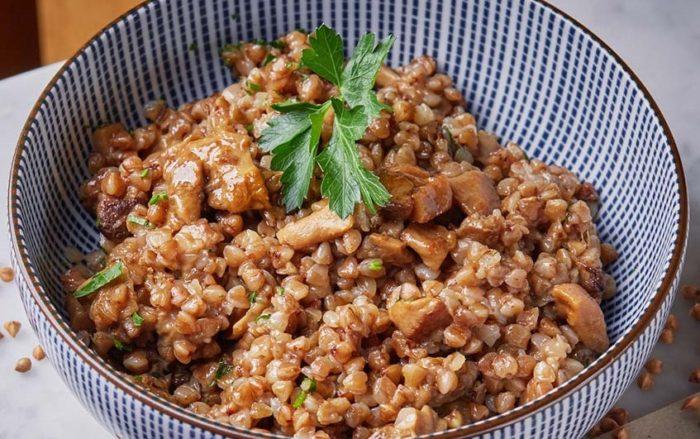
To prepare the dish, the following ingredients are required:
- buckwheat - 400 g;
- mushrooms - 250 g;
- onion - 4 heads;
- garlic - 4 cloves;
- dried mushrooms - 4o g;
- dill - 1 bunch;
- salt to taste.
Procedure:
- Prepare all the products: finely chop the greens, chop the onion into cubes, and finely grate the dried mushrooms into powder.
- Pour buckwheat with boiling water, observing a ratio of 1: 3. Add salt, mushroom powder, cover with a lid and a towel on top. Leave the cereal for 20 minutes.
- Pour sunflower oil into a frying pan and fry the onion in it. Add porcini mushrooms and keep on fire for 15 minutes.
- Place the buckwheat in the pan, and with it the garlic and herbs. Mix everything, cover and cook for 10-15 minutes.
It is best to serve the cooked dish in clay pots, then it will keep its heat longer.
Cooking mushroom omelet
 Required Ingredients:
Required Ingredients:
- egg - 4 pcs.;
- onion - 1 head;
- porcini mushrooms - 200 g;
- natural yogurt - 2 tbsp. l .;
- low-fat cheese - 30 g;
- salt, pepper - to taste.
Procedure:
- Fry chopped onions in a pan, add mushroom pieces, salt and pepper.
- A few minutes before cooking, add yogurt.
- Beat eggs in a separate bowl, add salt and pour into skillet.
- The omelet should be cooked over low heat, covered with a lid. The cooking time is 3-5 minutes.
- Put the finished dish on a plate and sprinkle on top with fried mushrooms, onions and cheese, previously chopped on a grater.
Description
White birch mushroom can be immediately recognized by its characteristic shape and color. In particular, the size of the cap varies up to 150 millimeters in diameter, although initially it has a somewhat semicircular shape, but over time it can easily transform into a flat shape familiar to the look. The surface of the mushroom cap is smooth, rather shiny, and has a light ocher color (slightly yellowish). The tubular layer itself is white, changes slightly over time, becomes light yellow. You can immediately distinguish it from the rest due to the presence of a unique mesh pattern in the upper area of the leg
It is worth paying attention to the flesh of the mushroom, which has a white color, is quite dense, and does not change its own color during cutting in the air. The aroma is pleasant, its typical mushroom aroma is noted, which is why it has become so popular with all mushroom pickers
Quite high nutritional properties are also noted, taking into account that in terms of taste it occupies the highest ratings among food mushrooms similar in purpose. In addition to the possibility of consumption in food, it also has incredible medicinal properties; it has been widely used in many recipes of traditional medicine.
Where can you find a mushroom in nature

It is important to note that the birch porcini mushroom is quite common in Russia. For example, he feels comfortable enough on sandy, as well as loamy, sandy loam soil, in other words, on those types of soils that are fairly well drained and at the same time cannot be excessively moistened
The germination of mushrooms on all continents located in the northern hemisphere, without exception, deserves special attention. As a rule, a kind of symbiosis of mushrooms is formed with such trees as spruce, birch, oak, even pine, which makes it easy to find it in the vastness of the forest, planting and not experience any complications. At the same time, you can easily find it in a coniferous, deciduous, mixed forest, where in the summer it is most often found in young plantings, groves, and in the fall, the mushroom is found next to paths, abandoned roads, old, fallen trees. However, he does not like to "settle" in damp places, prefers exclusively the presence of moss, lichen, it can also be found near trees, which are about twenty years old. There are no shares of harmful substances in it, you should not be afraid of poisoning.
Evaluation of taste, medicinal properties, benefits and possible harm
The unpleasant smell of a semi-white mushroom disappears after boiling or drying the fruit chalk. Otherwise, he is a worthy rival of his white counterpart. The most pleasant pickled.
If you regularly eat yellow hurts, then the condition of the skin and hair will improve, the nervous system, the work of the thyroid gland will normalize, and stress resistance will increase.
These fruits are rich in antioxidants that help fight cancer, stimulate the immune system, the brain and the entire body.
Attention! Mushrooms are not recommended for children under 7 years old, pregnant and lactating women, the elderly, as well as with exacerbation of diseases of the gastrointestinal tract, liver and kidneys. The danger of collecting yellow boletus lies in the large number of inedible species that can be confused with it.
Also, the mushroom tastes bitter and requires preliminary soaking.
The danger of collecting yellow boletus lies in the large number of inedible species that can be confused with it. Also, the mushroom tastes bitter and requires preliminary soaking.

Growing methods
Spikelets are usually grown using mycelium or spores.
- In the first case, planting material is bought in a special store and planted next to a birch in their area.
- In the second, overripe mushrooms are collected in the forest and the caps are soaked in 10 liters of water for a couple of hours. Then add 10 pieces of sugar and knead the mushroom pulp with your hands, after which they are planted on a prepared bed and sprinkled with a substrate.
In addition, birch trees can be grown from a part of the forest mycelium, which is dug up and transferred to the garden. Some gardeners grow crops from dried pieces after soaking them in water.
Definitioner
- Basidia (Basidia)
-
Lat. Basidia. A specialized structure of sexual reproduction in fungi, inherent only in Basidiomycetes. Basidia are terminal (end) elements of hyphae of various shapes and sizes, on which spores develop exogenously (outside).
Basidia are diverse in structure and method of attachment to hyphae.
According to the position relative to the axis of the hypha, to which they are attached, three types of basidia are distinguished:
Apical basidia are formed from the terminal cell of the hypha and are located parallel to its axis.
Pleurobasidia are formed from lateral processes and are located perpendicular to the axis of the hypha, which continues to grow and can form new processes with basidia.
Subasidia are formed from a lateral process, turned perpendicular to the axis of the hypha, which, after the formation of one basidium, stops its growth.
Based on morphology:
Holobasidia - unicellular basidia, not divided by septa (see Fig. A, D.).
Phragmobasidia are divided by transverse or vertical septa, usually into four cells (see Fig. B, C).
By type of development:
Heterobasidia consists of two parts - hypobasidia and epibasidia developing from it, with or without partitions (see Fig. C, B) (see Fig. D).
Homobasidia is not divided into hypo- and epibasidia and in all cases is considered holobasidia (Fig. A).
Basidia is the place of karyogamy, meiosis and the formation of basidiospores. Homobasidia, as a rule, is not functionally divided, and meiosis follows karyogamy in it. However, basidia can be divided into probasidia - the site of karyogamy and metabasidia - the site of meiosis. Probasidium is often a dormant spore, for example in rust fungi. In such cases, probazidia grows with metabasidia, in which meiosis occurs and on which basidiospores are formed (see Fig. E).

See Karyogamy, Meiosis, Gifa.
- Pileipellis
-
Lat. Pileipellis, skin - differentiated surface layer of the cap of agaricoid basidiomycetes. The structure of the skin in most cases differs from the inner flesh of the cap and may have a different structure. The structural features of pileipellis are often used as diagnostic features in descriptions of fungi species.
According to their structure, they are divided into four main types: cutis, trichoderma, hymeniderma and epithelium.
See Agaricoid fungi, Basidiomycete, Cutis, Trichoderma, Gimeniderm, Epithelium.
We are looking for a white birch mushroom by caps, we estimate by legs
The birch form of the porcini mushroom differs from other forms with a white, whitish, sometimes ocher-yellowish, sometimes light brownish, and sometimes even a reddish cap. What determines the color of the cap of the white birch mushroom is not clear to me. Moreover, even mycological scientists have not yet come to a consensus on this matter.
About Boletus f. betulicola
The cap of the porcini mushroom reaches 20 centimeters in diameter. Globular in youth, with age - hemispherical or almost flat, dry and smooth.
The tubular cushion in young mushrooms is white; it turns yellow with age.
In old mushrooms, the pillow is olive-yellow, unsightly in color, easily separates from the cap.
The flesh of the cap of a young mushroom is always white and dense, with a pleasant mushroom smell, does not darken on the cut.
Unlike other forms, the flesh of the cap of the white birch mushroom is white even under the skin.
About Boletus f. betulicola
The leg of a young mushroom is spherical-tuberous, with age it stretches in length up to 15 centimeters and becomes either cylindrical or tuberous-thickened downwards.
In thickness it reaches 6 centimeters. However, even with this size, the birch form cannot keep up with the pine one.
Next to the boletus, the leg of the white birch mushroom will seem thin. Although among the mushrooms of the birch form, there are "stalwart" ones.
The color of the leg is from white to light gray. On the leg there is a mesh pattern, which is clear and well noticeable or, conversely, faded.
The presence of a convex mesh is considered mandatory for any form of porcini mushroom. The net, as a rule, goes down to the base, but sometimes it is much shorter - 1/3 of the length from the cap.
The flesh of the leg is strong and dense, does not darken at the cut. The flesh of the cap and leg remains white even after drying, which is why the mushroom is called white.
I cannot help but notice that in some specimens of birch-shaped porcini mushrooms, the flesh of the leg is dryish and fibrous. Mycologists name two reasons: either the mushroom is old, or these are the last mushrooms of the layer (the last ones). Say what you like, but the strength of the mushroom directly depends on the weather. And in August and September we collected strong porcini birch mushrooms.
In addition, I strongly dislike the division of mushrooms into summer and autumn ones. Porcini mushrooms can be wormy both in summer and autumn. It all depends on the weather conditions of the current year.
Cut, pluck or twist ...
A mushroom is a fruiting body, in a word, a fruit. People pick fruits from trees in different ways and no one argues about which is the best way. It's the same with the mushroom: cut, pluck, twist. For the mycelium, this does not matter.
Elks, for example, even pull out porcini mushrooms from under the snow in order to feast on them in the winter hungry time. With a knife, excuse me, they do not walk in the forest, in addition, they do not cover mycelium with snow.
But what about such a mushroom?
It's good that I don't listen to either one or the other.
Otherwise, I would have to be left without such a wonderful mushroom. First I had to lift the litter, and then carefully cut off the mushroom and return the litter to its place.
Believe me, lovers of forest picnics are much more dangerous for mushrooms. Where they tend to stomp, the mushroom will never grow again. Mycologists even have a term like this: "trampling the forest."
Species diversity and description
Scientists have counted 18 forms among whites, but an ordinary amateur will not want to climb into such a jungle. And to meet some really only in other hemispheres of the planet. Therefore, let's take a closer look at what grows in the forests of Russia.
Spruce

White spruce mushroom (Boletus edulis f. Edulis) is large, up to 2 kg per specimen. The hat is chestnut-brown or "brick with a red tint", in the form of a hemisphere, eventually turning into a plane. The top is wrinkled, velvety to the touch. In young mushrooms, the edges are slightly turned inward.
The tubules are white, a yellow-green tint gradually appears. Leg height 6-20 cm, thickness 2-5. The mesh layer is located closer to the cap.
Distribution and collection time
Harvesting is possible from early June to early October in spruce-pine and mixed forests - wild and park. They love the neighborhood with spruce.
Oak

The oak cep (Boletus quercicola) has a cap most often of a coffee-gray color, light blotches are possible, with a diameter of 5-20 cm, fleshy and dense. With age, it gradually begins to wrinkle. With increasing humidity, the surface becomes shiny, slightly slimy.
The leg is widened or in the form of a club, 6-20 cm high and 2-6 cm in diameter. The inner part is more fragile than in other species.
Where and in what season is it harvested?
Oak porcini mushrooms grow from May to October next to oak trees and mixed vegetation of the middle and southern zone of the center of the country, the forests of the Caucasus, in Primorye. They spread widely, sometimes in clusters.
Birch

Birch cep (Boletus betulicola) - the fruit body is much larger than that of other brethren. The hat reaches 5-15 cm in diameter, but at times grows up to 25-27 cm. The color is light - from white to light coffee, can slightly wrinkle, crack in the heat.
The tubules are white, with the decrepitude of the mushroom comes a creamy shade. The inside is dense, when dried it remains white. The leg is barrel-shaped, white-brown, the mesh is closer to the cap, 5-13 cm in height, 1.5-4 in width.
Distribution and collection time
White birch mushroom is present in all forests of the European part of Russia, the territory of the middle latitudes of North and Northeast Asia, the Caucasus, the tundra zone - among the northern birch forests. Any soil (but does not take root on peat bogs), the main thing is that birches or at least aspens grow nearby.
You can find it from the beginning of summer to October. Some handsome men can survive until the first cold weather. Cut gently 1.5-2 cm from the ground. You need to look for birch porcini mushrooms on the outskirts of the forest and along nearby roads.
Pine

Pine cep (Boletus pinophilus), also called boar, looks like a "fat man". The height of the leg is from 5 to 16 cm, with a diameter of 4-10 cm, more thickened at the base. The surface is completely "shrouded" in a reddish or light brownish mesh.
The diameter of the cap is 5-25 cm.The general color is dark brown, there may be a variability of reddish shades, slightly pink along the contour, closer to light in newly grown ones. The lower part is white-yellow in color, darkens with increasing age. The flesh at the break is white, under the skin it is brown with a red tint, of a weaker structure than that of the white birch mushroom.
Where and in what season is it harvested?
Boar white mushroom is harvested in the Siberian taiga, coniferous forests of the western half of the European part of the country and in the northeast from July to 15 October. Prefers sandy soils of a pine forest, old pine forests with mosses and lichens. Can be found in forests mixed with pine.
It is important to collect until the tubular layer has acquired a greenish tint - old specimens can lead to poisoning!
Varieties
Boletus mushrooms grow everywhere in the forests of Russia, and there are a great many species of them. It can be seen that they are all from the same genus. They are distinguished only by the nuances of their appearance. All belong to the first taste category, each has an inedible double. Therefore, starting a "quiet hunt", carefully study the external signs of those mushrooms that are found in your area.
Pine
Its external features practically repeat the general description of boletus. What are the differences:
- The hat is red-brown with a diameter of 8-25 cm. The shade is purple.
- Pulp. Under the skin it is pink.
- The leg is very thick, short - up to 15 cm. Above there is a light brown mesh.
- The thickness of the tubular body is 2 cm. The shade is yellowish.
It has an early shape with a lighter head and flesh. Growth begins at the end of spring and continues until October. It settles under the pine trees - hence the name. With them, it forms mycorrhiza - fungus root. Occurs on sandstones, alone and in families. Distribution area - Europe, America, the European part of Russia.

Birch
Its second name is spikelet. It is harvested when the earing of rye fields begins. Distinctive features:
- The hat is light yellow, 5-15 cm in diameter. The flesh has no pronounced taste. It does not darken at the break.
- The leg is barrel-shaped, with a light mesh.
- The thickness of the tubular layer is 2.5 cm. The shade is yellowish.
It prefers to grow under birches. They grow singly and in groups. Favorite places - on the edges, near the roads. Distribution area - Western Europe, Siberia, the Far East. The harvesting season is June-October.

Dark bronze
Hornbeam or copper. Species differences:
- Rounded fleshy cap with a diameter of 7-17 cm. Dark shades. Sometimes cracked.
- The pulp is white. With a pleasant aroma and taste. In a fault, it changes color.
- Differs in a massive leg - it is pinkish-brown. Covered with brown mesh.
Tubular layer 2 cm thick. Yellow, when pressed - turns green.
Grows in deciduous forests in warm climatic zones. Distribution - Europe, North America.
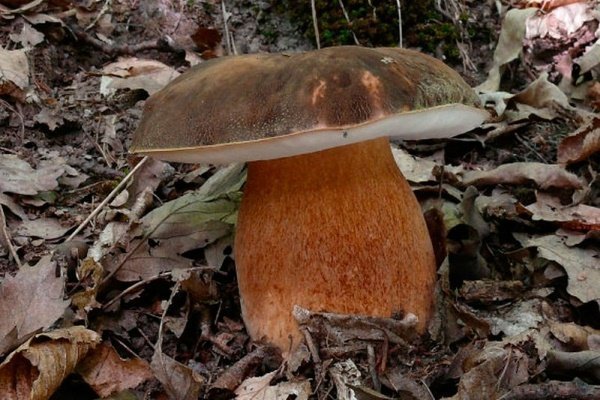
Other varieties
There are also such varieties of porcini mushroom:
- Reticulate. He has a brownish or light ocher cap. The leg is short, cylindrical. Can be confused with a flywheel. Prefers beeches and hornbeams. It grows in Europe, North Africa and North America. Has a pronounced mesh on the leg. Fruiting time is June-September. It is rare.
- Oak. The hat is grayish. Sometimes there are light spots on it. It differs from other boletus in looser pulp. Prefers oak groves. Habitat - Caucasus, Primorsky Territory. It has a brown cap, very similar to a gall fungus.
- Semi-white mushroom. The color of the cap is light brown or clay. Dense pulp - smells like carbolic acid. Distribution area - Carpathian region, Polesie, southern Russia. There is no mesh pattern on the leg. The hat is light brown.

White mushroom net

White oak mushroom

Semi-white type of porcini mushroom
Growing
The porcini mushroom, despite its unsurpassed taste, is not grown on an industrial scale - it is unprofitable. Usually, amateur gardeners are engaged in cultivation. There must be coniferous or deciduous trees on the personal plot.There should be no fruit trees, cultivated bushes and vegetables nearby. The most difficult thing in growing boletus is creating conditions for the successful creation of connections between tree roots and mycelium.
It is desirable that the site is adjacent to the forest. If this is not possible, you need to have at least a few pines, aspens, birches, oaks or firs on the future "plantation". Trees on the site must be at least 8 years old. There are two ways to grow porcini mushrooms - from the mycelium and from the caps.
Growing from mycelium
Cultivation begins with the purchase of planting material. You need to buy mycelium in specialized stores. Next, the site is prepared and the mycelium is planted:
- The soil is exposed near the trunks. The top layer is removed - about 20 cm. The diameter of the circle should be about 1-1.5 m. The removed soil is saved - it will be needed to cover the crops.
- A layer of peat is applied to the area prepared for planting. The use of rotted compost is allowed. The fertile layer should not be thicker than 2-3 cm.
Put the mycelium on top. The interval between adjacent pieces is about 30 cm. The pieces are laid out according to the principle of a checkerboard pattern. The mycelium is covered with previously removed soil. Water abundantly. Pour about 3 buckets of water under one tree
It is poured carefully so that the soil does not erode. Next, mulch the poured soil with straw
The thickness of the layer is 30 cm. This is done to maintain the desired humidity - so that the mycelium does not dry out. Crops need to be watered weekly. Be sure to put nutritious food in the water.
Before freezing, areas with mushrooms are covered. For insulation, you can use - moss, spruce branches, fallen leaves. With the arrival of spring, the insulation is raked with a rake.
A year will pass, and the first fungi can be removed. If you properly care for the myceliums, water and feed on time, the mushroom "plantation" will bear fruit for up to 5 years.

Growing from hats
To implement this method, you will need to get some mushroom caps. Find mature, or better - overripe boletus in the forest. The cap should be at least 10 cm in diameter. It is best if the cap has a greenish tint when broken - it indicates the maturity of the spores.
The procedure for preparing the site and planting seed:
- A dozen caps are soaked in a bucket of water. It is desirable that the water is rainwater. Add one thing per 10 liters:
- alcohol - 3-5 tbsp. l .;
- or sugar - 15-20 g.
Mushrooms should be soaked no later than 10 hours after picking - otherwise they will deteriorate.
- After 24 hours, the boletus caps should be kneaded. Crumple until you get a jelly-like mass. Straining it through cheesecloth, water is separated from the mushroom tissue with spores.
- Prepare a place for landing - exactly as in the previous version. But be sure to water peat or compost with tannins - for disinfection. To prepare the solution, take:
- black tea - 100 g;
- or oak bark - 30 g.
Tea is brewed in 1 liter of boiling water. The second option is to boil the oak bark for 1 hour. The cooled solution is poured over the soil - 3 liters under each tree.
- Then they start planting - water containing boletus spores is poured onto the prepared fertile layer. The solution is stirred while pouring. Crushed hats are placed on top, the planting is closed with previously removed soil, and covered with straw.
It remains to take care of the crops - water regularly, sparing no water. If the ground dries up, the mycelium will die before it can germinate. For the winter, the site is insulated with spruce branches or leaves. They rake in the spring. The first mushrooms will appear next summer or autumn.

Indoor cultivation
You can grow boletus indoors:
- First, the premises are sterilized with 1% chlorine solution - it kills mold and parasites.
- Creates warm and humid conditions. They put barrels of water or put wet sawdust.
- Prepare a substrate with mycelium. They put it in bags. Incisions are made.
- The bags are placed at intervals of 5 cm.
- The temperature is maintained at + 23-25 ° C, no more. Excess will destroy the mycelium.
Boletus deservedly received its royal status - it surpasses all known mushrooms in taste and usefulness. If it is not possible to find a sufficient number of boletus in nature, they can be grown artificially.









